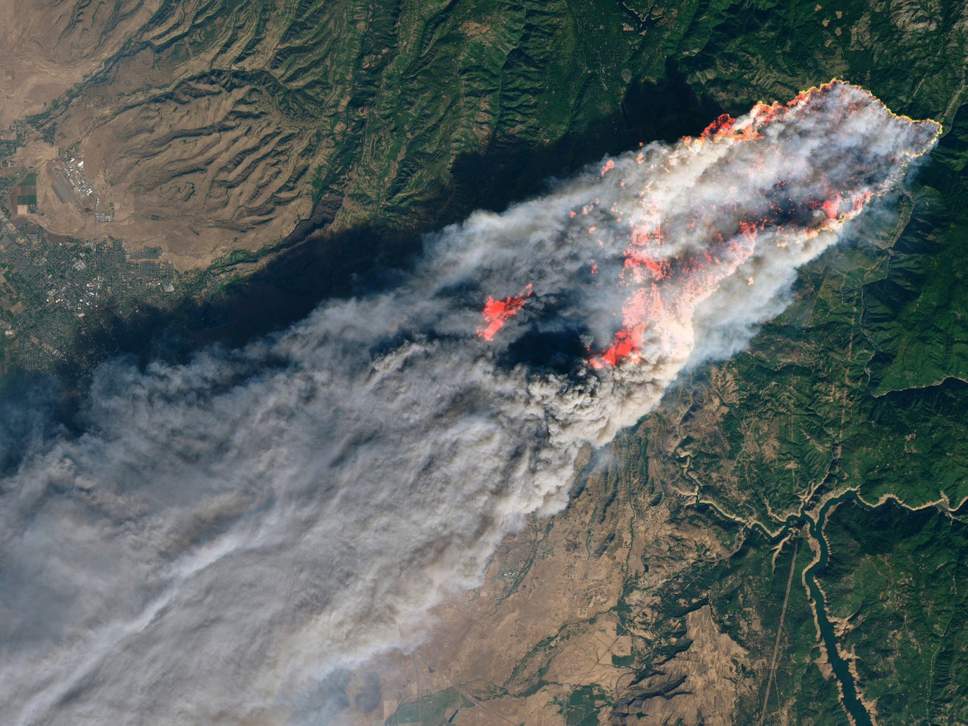I want to begin by sending well wishes to all those who continue to be affected by the Camp Fire in Northern California. A terrible loss of life and property in a beautiful area of the country. I returned to Chico yesterday, where the air quality was 107 (down from 500+) and my place was in the clear. A photographer/videographer friend of mine found his house spared because of the efforts of firefighters to bulldoze a trench through his backyard. Another friend of mine from Sierra Nevada was not so lucky, but she and her dogs are safe.
 Whether it’s the Camp or Carr Fires this year, the fires that ravaged areas of Napa, Lake, Sonoma and Mendocino Counties in 2017, or countless other natural disasters, I’m thankful for the heroic efforts of first responders. And I’m reminded how important clear communication is at all times, but especially in times of crisis. It’s with that in mind that I drafted this email for you and your team, hoping that it might help provide some straightforward recommendations on how to respond to a potential crisis using social media channels.
Whether it’s the Camp or Carr Fires this year, the fires that ravaged areas of Napa, Lake, Sonoma and Mendocino Counties in 2017, or countless other natural disasters, I’m thankful for the heroic efforts of first responders. And I’m reminded how important clear communication is at all times, but especially in times of crisis. It’s with that in mind that I drafted this email for you and your team, hoping that it might help provide some straightforward recommendations on how to respond to a potential crisis using social media channels.
Social Crisis Management Plan ⇲
Just to be clear, I’m using the word, “crisis,” as a catch-all for any event or activity with potential negative consequences to your brand reputation, sales or team members. I’m by no means drawing a parallel between your business obstacles and the Camp Fire, for example. But any concentrated attack aimed at your business could have significant and lasting impact on your ability to survive, especially in the small-to-mid-tier craft beer segment. Let’s consider some practical examples:
- Product shortage
- Tasting room incident
- Voluntary or mandatory recall
- Negative publicity
- Business loss
There are countless other situations that could roadblock your normal operations. The point is to take some time, perhaps during the annual budgeting or planning process, to think through what-if scenarios, resources you have available and how you might address the challenge in front of you.
 Why take time now for something that may never happen? You’ve got production and 80 other issues to worry about, right?! Quite simply, because when it does happen you won’t have the luxury of time to thoughtfully plan a response. You’ll be in reaction mode, and depending on the scope of impact you could be addressing team members, distributors, retailers, partners and possibly customers within hours of assessing the situation. Not trying to scare you and the team, I’m just saying that it does happen – I’ve been right in the middle of it, managing the communications to millions of people. Tensions are high and keeping on-point is critical to getting through the challenge while minimizing the overall brand and business damage.
Why take time now for something that may never happen? You’ve got production and 80 other issues to worry about, right?! Quite simply, because when it does happen you won’t have the luxury of time to thoughtfully plan a response. You’ll be in reaction mode, and depending on the scope of impact you could be addressing team members, distributors, retailers, partners and possibly customers within hours of assessing the situation. Not trying to scare you and the team, I’m just saying that it does happen – I’ve been right in the middle of it, managing the communications to millions of people. Tensions are high and keeping on-point is critical to getting through the challenge while minimizing the overall brand and business damage.
Disclaimer: it’s always best practice to consult with an expert in the field when you’re in a situation that threatens your ability to do business. Somebody flaring up on a craft beer review site or posting negative comments to your Facebook page usually doesn’t constitute a crisis worth bringing in the heavy hitters. However, if your local geography and beyond is impacted and a marked decrease in sales volume is unavoidable, it benefits you to have the contact information of a crisis management, public relations and social media expert available. They typically have experience handling local and national media, speaking on behalf of the company (if needed) and minimizing any negative exposure. All areas of internal and external communication may need to be addressed: a topic too broad and important to cover in a single email. Which is why I’m focusing today on social media in times of crisis: the speed and accuracy of message spread, if not kept in-check, could shape or even shatter public perception of your brand.
USING SOCIAL MEDIA IN A CRISIS
The two-way and immediate nature of social media make it highly unstable if not managed appropriately during a crisis situation. The steps below may help your craft beverage brand outline a crisis management approach that you can stick to in time(s) of need:
First, take a breath: you or someone on your team found something wrong with business operations or heard it from a customer. Before you react, take a minute to assess the situation and collect whatever data you can. Now is not the time to be rushing to respond! Separate fact from emotion by asking the following questions:
- What is the problem requiring response?
- Who is the affected party?
- What is the consumer visibility risk?
- How quickly to address?
 Pause all communications: from tasting room to customer service, all outbound dialogue should stop long enough for those communicating to be briefed on the situation and the appropriate response. What we’re looking for is a singular voice with consistent messaging points. Any confusion that exists internally is bound to be amplified outside! Also, be sensitive to individual needs: in the case of a natural disaster which impacts much more than just your business, holding off on social posts helps clear the path for those impacted to look for valuable [survival] info. There’s plenty of time for your posts after things have settled down.
Pause all communications: from tasting room to customer service, all outbound dialogue should stop long enough for those communicating to be briefed on the situation and the appropriate response. What we’re looking for is a singular voice with consistent messaging points. Any confusion that exists internally is bound to be amplified outside! Also, be sensitive to individual needs: in the case of a natural disaster which impacts much more than just your business, holding off on social posts helps clear the path for those impacted to look for valuable [survival] info. There’s plenty of time for your posts after things have settled down.
Address the issue directly: if confronted on social media, acknowledge that you are aware of an issue where news of the crisis first surfaced (i.e. Twitter). It is best to do this with a prepared post that states the facts about and reiterates your commitment to addressing the issue in a timely manner with next steps outlined. Sprout Social offers social listening tools to make sure you’re catching all conversations around the topic. These tools are also called “negative keyword filters” for isolating profanity in posts, but can also be used to identify and track negative opinion.
Enable self-service tools: where possible, allow customers access to as much information as you have available BEFORE they ask for it. This can be done using a self-service website or updated FAQs document. Facebook offers auto-responder and bot-based customer service that helps customers find answers to commonly-asked questions before initiating direct contact with the brand or crisis representative. From the Convince & Convert website, consider the following components when drafting your FAQs:
- Acknowledgment of the crisis
- Details about the occurrence
- Photos and/or videos, if available
- How the company found out
- Who was alerted when and how
- Specific actions taken in response
- Real or potential effects
- Steps taken to prevent future occurrence
- Contact information for real people at the company
 Consider changing your profile and cover images to help users quickly identify visually that there has been some operational change in the way you do business. This isn’t a company rebranding, and should be approached subtly without much (if any) formal announcement. When the issue is resolved, replacing these images with standard branding helps cue customers that things are returning to normal. Like this recent example from Southwest Airlines in response to a tragic accident earlier this year.
Consider changing your profile and cover images to help users quickly identify visually that there has been some operational change in the way you do business. This isn’t a company rebranding, and should be approached subtly without much (if any) formal announcement. When the issue is resolved, replacing these images with standard branding helps cue customers that things are returning to normal. Like this recent example from Southwest Airlines in response to a tragic accident earlier this year.
Give customers an outlet…to a point: it’s okay for your fans and followers to use your social media channels to vent. If they use other channels, the response often falls out of your direct control where lack of response can grow negativity towards the brand. Just remember, limit yourself to responding twice publicly to individuals. After that, take the message private/off-wall to address ongoing concerns or rants.
Build a community of partners: states Tyler Rollins, PhD Communications and Media Studies, “Teaming up with other businesses [impacted by the issue] can have a synergistic effect. [For example] Relief efforts by local brewers to support those impacted by the Camp Fire have seen a ton of share activity: not just by individuals, but by other [national and global] breweries and businesses out of respect for the spirit of community, collaboration and charity.” There can be strength and solidarity, even in the highly-competitive craft beer industry, for those who choose class over cash, mobilizing their personal network in support of the those impacted.
Document and archive: let’s hope this doesn’t happen again! However, for learning as well as potentially legal purposes, be sure to document and archive your communication during this time. This includes screenshots of social posts, drafts of responses, templates, etc. Once resolved (and with clearer heads), take a look at all the activity associated with the crisis and adjust your plan for future use.
Sprout Social Discount
If you haven’t already, visit SproutSocial.com, a tool to help monitor, grow and track social media efforts. I’ve evaluated a number of tools and I find this to be the most insightful and easiest to use, with access to a single interface for posting content to all major social platforms. As an advisor, I qualify for discounted pricing of $150/month for up to 2 users and 3 social profiles (i.e. Facebook, Instagram and Twitter) for Enterprise-level services. Additional profiles and users can be purchased.
What I’m reading this week:
1. Sierra Nevada to brew Resilience IPA for Camp Fire Relief: in order to raise funds for victims, Sierra Nevada is donating 100% of the Resilience IPA sales to Camp Fire relief and is asking every other brewery to do the same on November 27. So much respect for Ken Grossman and his team, I’m proud to have worked for him. I also appreciated Blue Note Brewing’s quick response by hosting a donation event and Flying Saucer’s “Fire Sale” event.
2. Everyone has a growler subscription: whether you’re a Ritual Barrel Room Member (Mraz), Friend of the Brewery (Track 7), League Member (Bike Dog) or Grauler Club Member (New Helvetia), Sacramento’s beer scene is exploding with clubs. I don’t know why it surprises me, but these offer similar benefits (custom growlers, discounts, special access/events) AND THEY COST $400-$650!! Seems like everyone got the same memo…basically on the same day…expect others to follow suit but if we’ve learned anything from other markets, program interest at that price point will dry up in a couple years.
MailChimp archive:
https://mailchi.mp/76a152120ebd/181120_social_crisismanagement?e=a83dcf3085
Download:
https://app.box.com/s/59nefsdcxm2cmxuh71tkscofyz19xfew